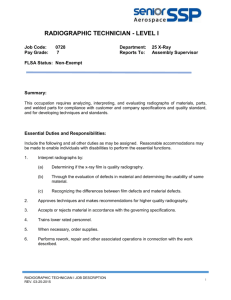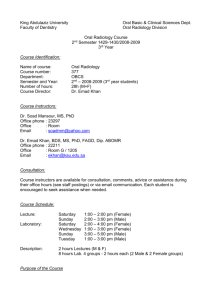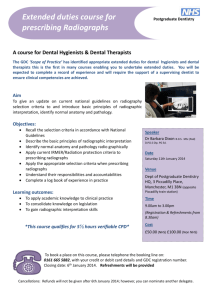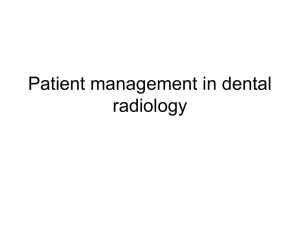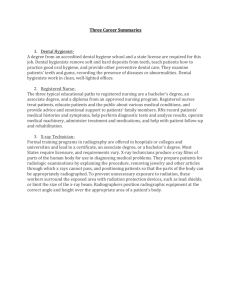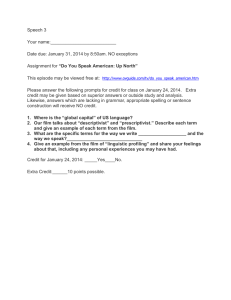College of San Mateo Official Course Outline COURSE ID: Semester Units/Hours:
advertisement
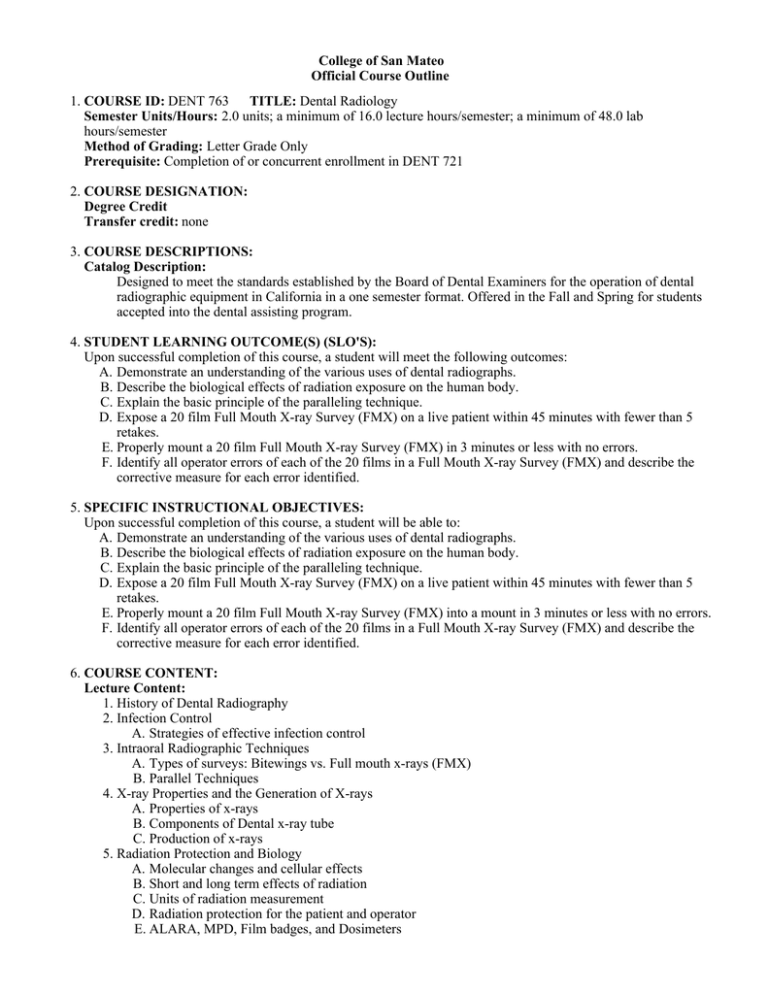
College of San Mateo Official Course Outline 1. COURSE ID: DENT 763 TITLE: Dental Radiology Semester Units/Hours: 2.0 units; a minimum of 16.0 lecture hours/semester; a minimum of 48.0 lab hours/semester Method of Grading: Letter Grade Only Prerequisite: Completion of or concurrent enrollment in DENT 721 2. COURSE DESIGNATION: Degree Credit Transfer credit: none 3. COURSE DESCRIPTIONS: Catalog Description: Designed to meet the standards established by the Board of Dental Examiners for the operation of dental radiographic equipment in California in a one semester format. Offered in the Fall and Spring for students accepted into the dental assisting program. 4. STUDENT LEARNING OUTCOME(S) (SLO'S): Upon successful completion of this course, a student will meet the following outcomes: A. Demonstrate an understanding of the various uses of dental radiographs. B. Describe the biological effects of radiation exposure on the human body. C. Explain the basic principle of the paralleling technique. D. Expose a 20 film Full Mouth X-ray Survey (FMX) on a live patient within 45 minutes with fewer than 5 retakes. E. Properly mount a 20 film Full Mouth X-ray Survey (FMX) in 3 minutes or less with no errors. F. Identify all operator errors of each of the 20 films in a Full Mouth X-ray Survey (FMX) and describe the corrective measure for each error identified. 5. SPECIFIC INSTRUCTIONAL OBJECTIVES: Upon successful completion of this course, a student will be able to: A. Demonstrate an understanding of the various uses of dental radiographs. B. Describe the biological effects of radiation exposure on the human body. C. Explain the basic principle of the paralleling technique. D. Expose a 20 film Full Mouth X-ray Survey (FMX) on a live patient within 45 minutes with fewer than 5 retakes. E. Properly mount a 20 film Full Mouth X-ray Survey (FMX) into a mount in 3 minutes or less with no errors. F. Identify all operator errors of each of the 20 films in a Full Mouth X-ray Survey (FMX) and describe the corrective measure for each error identified. 6. COURSE CONTENT: Lecture Content: 1. History of Dental Radiography 2. Infection Control A. Strategies of effective infection control 3. Intraoral Radiographic Techniques A. Types of surveys: Bitewings vs. Full mouth x-rays (FMX) B. Parallel Techniques 4. X-ray Properties and the Generation of X-rays A. Properties of x-rays B. Components of Dental x-ray tube C. Production of x-rays 5. Radiation Protection and Biology A. Molecular changes and cellular effects B. Short and long term effects of radiation C. Units of radiation measurement D. Radiation protection for the patient and operator E. ALARA, MPD, Film badges, and Dosimeters 6. X-ray Film Holders 6. X-ray Film Holders A. Snap-a-ray B. Styrofoam bite blocks C. Bitewing tabs D. XCP-Ring 7. Mounting Techniques A. Normal anatomy and film mounting a. Teeth and adjacent structures b. Mounting procedures c. Tips on mounting dental radiographs 8. Film Placement A. Vertical angulation B. Horizontal angulation C. Imaginary lines of the face and cone placement 9. Film Processing and Quality Assurance A. Film composition B. Latent image formation C. Concepts of film processing D. Chemical composition of solutions E. Care of solutions F. Darkroom vs. Automatic processing G. Diagnosing processing errors H. Duplicating films 10. Extraoral Radiography A. Lateral oblique jaw projections B. Cephalometric Projections C. Temporomandibular joint (TMJ) views D. Maxillary sinuses 11. Accessory Radiographic Techniques and Patient Management A. Bisecting the angle technique B. Occlusal radiographs on adult and pedo patients C. Patient management D. Patient with disabilities E. Anatomic conditions F. Radiographic technique as it applies to: edentulous, pedo, and supplemental 12. Principles of Paralleling Technique 13. Operator Errors A. Overlapping B. Cone cuts C. Elongation D. Foreshortening E. Double exposure F. Unexposed film G. Film placement 14. Bisecting the Angle Technique 15. Landmarks of the Face 16. Radiographic Presentation of Lesions A. Radiographic changes resulting from infection, periodontal disease, and/or dental caries B. Radiographic features of dental anomalies C. Radiographic features of common oral lesions 17. Image Characteristics 18. Digital Imaging A. CCD's and digital imaging Lab Content: 1. Infection Control A. Universal precautions 2. Intraoral Radiographic Techniques A. Parallel Techniques B. Bisecting Technique 3. X-ray Film Holders A. Snap-a-ray B. Styrofoam bite blocks C. Bitewing tabs D. XCP-Ring 4. Film Placement A. Vertical angulation B. Horizontal angulation 5. Film Processing and Quality Assurance A. Care of solutions B. Darkroom vs. Automatic processing of films C. Overlapping D. Cone cuts E. Elongation F. Foreshortening G. Double exposure 7. REPRESENTATIVE METHODS OF INSTRUCTION: Typical methods of instruction may include: A. Lecture B. Lab C. Discussion D. Observation and Demonstration E. Other (Specify): worksheets, homework and reading assignments, hands on demonstrations at the x-ray unit, and slide presentations. 8. REPRESENTATIVE ASSIGNMENTS Representative assignments in this course may include, but are not limited to the following: Writing Assignments: Weekly or bi-weekly lab reports evaluating the radiographs previously taken. Reading Assignments: Weekly readings from the assigned texts. 9. REPRESENTATIVE METHODS OF EVALUATION Representative methods of evaluation may include: A. Class Participation B. Class Performance C. Class Work D. Exams/Tests E. Homework F. Lab Activities G. Portfolios H. Quizzes I. Written examination J. Completion of worksheets and homework assignments, completion of radiographic surveys on both dexter mannikins and live patients, participation in lab and lecture sessions, and final examination. 10. REPRESENTATIVE TEXT(S): Possible textbooks include: A. Miles, D and VanDis, M. Radiographic Imaging for the Dental Team, 4th ed. Saunders Publishing Company, 2009 B. Bird, D and Robinson, D. Modern Dental Assisting, 10th ed. Saunders, 2011 Other: A. DENT 763 Radiology Reader including Syllabus. Updated Fall 2012. Renee Herold, Instructor Origination Date: March 2009 Curriculum Committee Approval Date: October 2013 Effective Term: Fall 2014 Course Originator: Beth LaRochelle
